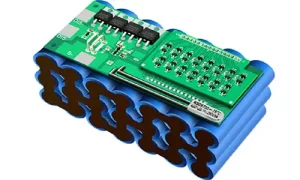Are the batteries you are using safe? PCM, PCB, and BMS are all modules that protect the safety of batteries and allow users to avoid accidents such as battery swelling, short circuits, and explosions. This article will help you understand the concepts of PCM, PCB, and BMS and their differences.
Part 1. What’s PCM? ( Protection Circuit Module )
In electronics and batteries, PCM stands for Protection Circuit Module. It’s a vital component designed to safeguard rechargeable batteries from potential damage caused by overcharging, over-discharging, short circuits, and high temperatures.
The PCM is a guardian for your battery, ensuring it operates within safe parameters to prolong its lifespan and prevent hazardous situations like overheating or explosion.
How does PCM work?
Overcharge Protection
The PCM monitors the voltage of the battery during charging. When the voltage reaches a predetermined threshold, the PCM automatically cuts off the charging current, preventing overcharging, which can lead to battery degradation or even fire.
Over-Discharge Protection
Similarly, the PCM keeps an eye on the battery voltage during discharge. Suppose the voltage drops below a safe level, indicating the battery is excessively drained. In that case, the PCM shuts off the power output to prevent further discharge, thereby protecting the battery from damage.
Short Circuit Protection
In the event of a short circuit, where the positive and negative terminals of the battery are directly connected without any resistance, the PCM swiftly detects this abnormality. It interrupts the current flow to prevent excessive heat buildup or explosion.
Temperature Protection
High temperatures can be detrimental to battery health. The PCM includes temperature sensors to detect any abnormal temperature rise. If the temperature surpasses a safe threshold, the PCM limits the current flow or cuts off power until the temperature returns to a safe range.
Balancing Cells
In multi-cell battery packs, the PCM ensures that each cell receives an equal charge and discharges evenly. This helps maximize the battery pack’s overall lifespan and performance.
Part 2. What’s PCB? ( Protection Circuit Board )
PCB, or Protection Circuit Board, is a crucial component in various electronic devices to safeguard against potential damage caused by electrical faults or environmental factors.
How does PCB work?
Overvoltage Protection
PCBs are equipped with components such as varistors or voltage regulators that monitor the voltage levels within the circuit. If the voltage exceeds safe limits, these components quickly divert excess voltage or disconnect the circuit, preventing damage to sensitive electronic components.
Overcurrent Protection
Like overvoltage protection, PCBs employ fuses, circuit breakers, or current-limiting devices to detect and manage overcurrent situations. When the current exceeds the rated capacity of the circuit, these protective elements interrupt the current flow and prevent overheating or damage.
Short Circuit Protection
PCBs include:
- Fuses.
- Polymeric positive temperature coefficient (PPTC) devices.
- Electronic switches detect short circuits—instances where current flows along unintended paths due to a fault in the circuit.
These protective measures isolate the affected portion of the circuit to prevent further damage.
Temperature Protection
PCBs integrate thermal sensors or cutoff switches to monitor the temperature of critical components. If the temperature rises above safe levels, these protective features activate, either reducing the power supplied to the circuit or shutting it down entirely until temperatures normalize.
EMI/RFI Protection
PCBs may incorporate shielding layers or filters to mitigate electromagnetic interference (EMI) and radio frequency interference (RFI), which can disrupt the functioning of electronic devices. These protective measures help maintain signal integrity and prevent data corruption or loss.
Part 3. What’s BMS? ( Battery Management System )
BMS, or Battery Management System, is critical in rechargeable battery packs, ensuring their safe and efficient operation while maximizing lifespan and performance.
How does BMS works?
Cell Monitoring
BMS continuously monitors the voltage and temperature of individual battery cells within the pack. This monitoring ensures that each cell operates within safe limits and prevents overcharging or over-discharging, which can lead to cell damage or failure.
State of Charge (SoC) Estimation
BMS utilizes algorithms to estimate the battery pack’s State of Charge (SoC). SoC estimation helps users gauge the battery’s remaining capacity accurately, allowing for better management of power usage and preventing unexpected shutdowns.
Balancing
BMS performs cell balancing in multi-cell battery packs to ensure each cell receives an equal charge/discharge. This prevents cell imbalances, which can degrade overall battery performance and lifespan.
Overvoltage and Overcurrent Protection
BMS includes protective circuits that prevent overvoltage and overcurrent situations. Suppose the voltage or current exceeds safe thresholds. In that case, the BMS cuts off power to the battery pack, protecting it from damage and ensuring user safety.
Temperature Management
BMS monitors and controls the temperature of the battery pack. If temperatures exceed safe levels, the BMS activates cooling systems or reduces charging/discharging rates to prevent overheating and maintain battery health.
Communication Interface
Many BMS systems feature communication interfaces (such as CAN bus or UART) to provide real-time data on battery status, health, and performance. This allows for remote monitoring and control, facilitating integration with larger systems like electric vehicles or renewable energy storage systems.
Fault Detection and Diagnostics
BMS continuously checks for faults such as short circuits, open circuits, or cell degradation. When a fault is detected, the BMS alerts the user or takes corrective action to mitigate the issue, ensuring the reliability and safety of the battery pack.
Part 4. What is the difference between PCM, PCB, and BMS?
PCM (Protection Circuit Module), PCB (Protection Circuit Board), and BMS (Battery Management System) are all components used in electronic devices and battery systems to ensure safety and efficiency. Still, they serve different purposes and have distinct features.
PCM (Protection Circuit Module)
- PCM protects individual battery cells from overcharging, over-discharging, short circuits, and high temperatures.
- It is typically integrated into rechargeable battery packs to safeguard against potential damage and ensure the longevity of the batteries.
- PCM monitors voltage and current at the cell level. It prevents unsafe conditions, such as cutting off charging or discharging currents when necessary.
PCB (Protection Circuit Board)
- PCB is a circuit board incorporating protective features to safeguard electronic circuits from various electrical faults and environmental factors.
- While PCBs can include battery protection, they are not exclusively designed for battery management.
- PCBs may include overvoltage protection, overcurrent protection, short circuit protection, temperature monitoring, and other protective features tailored to the specific application.
BMS (Battery Management System)
- BMS is a comprehensive system designed to manage and control rechargeable battery packs.
- It encompasses a range of functions beyond simple protection, including cell monitoring, state of charge estimation, balancing, temperature management, communication interfaces, and fault detection.
- BMS ensures battery packs’ safe and efficient operation by actively managing parameters such as voltage, current, temperature, and state of charge to optimize performance, maximize lifespan, and prevent damage to the batteries and connected devices.
Related Tags:
More Articles

White Stuff on Battery Terminals: A Step-by-Step Cleaning and Maintenance Guide
White stuff on battery terminals is corrosion. Learn how to clean it safely, prevent damage, and keep your battery running strong with simple steps.
Understanding How Glass Mat Batteries Work: Technology, Benefits, and Limitations
Glass mat batteries power cars, RVs, and solar systems. Learn how they work, their benefits, and what to consider before choosing one.
A Buyer’s Guide for AA Size Lithium Battery
Discover the power of AA size lithium batteries—types, voltage, capacity, and more! Learn how to choose the best one for your needs. Read now!
Li-Ion Battery Prices – Where to Buy Cheap & Safe
Discover li-ion cell prices, key market factors, and how to find affordable custom batteries from top suppliers like Ufine Battery.
How Long Does a 2200mAh Battery Last?
Discover everything about 2200mAh batteries—types, charging time, lifespan, and whether it’s enough for your device.




